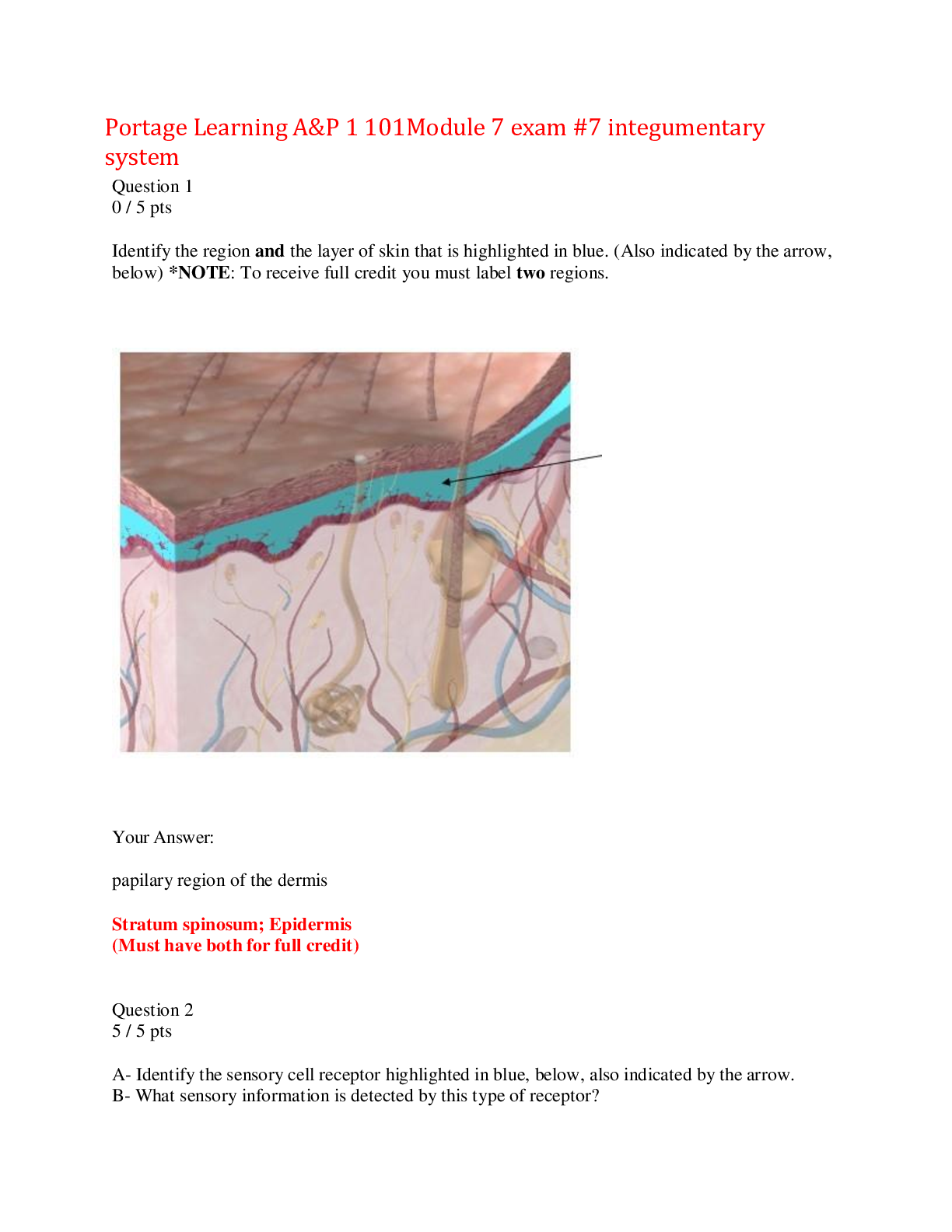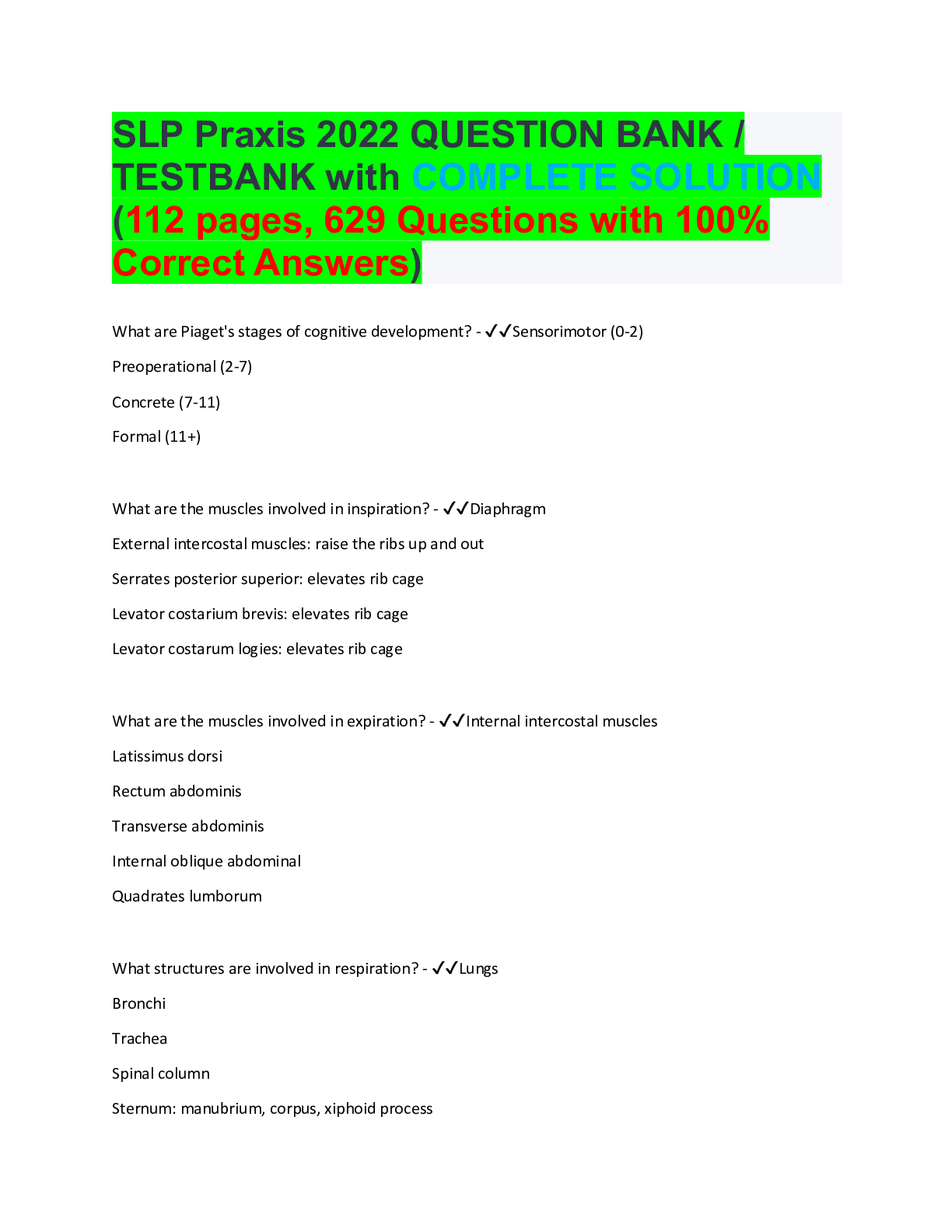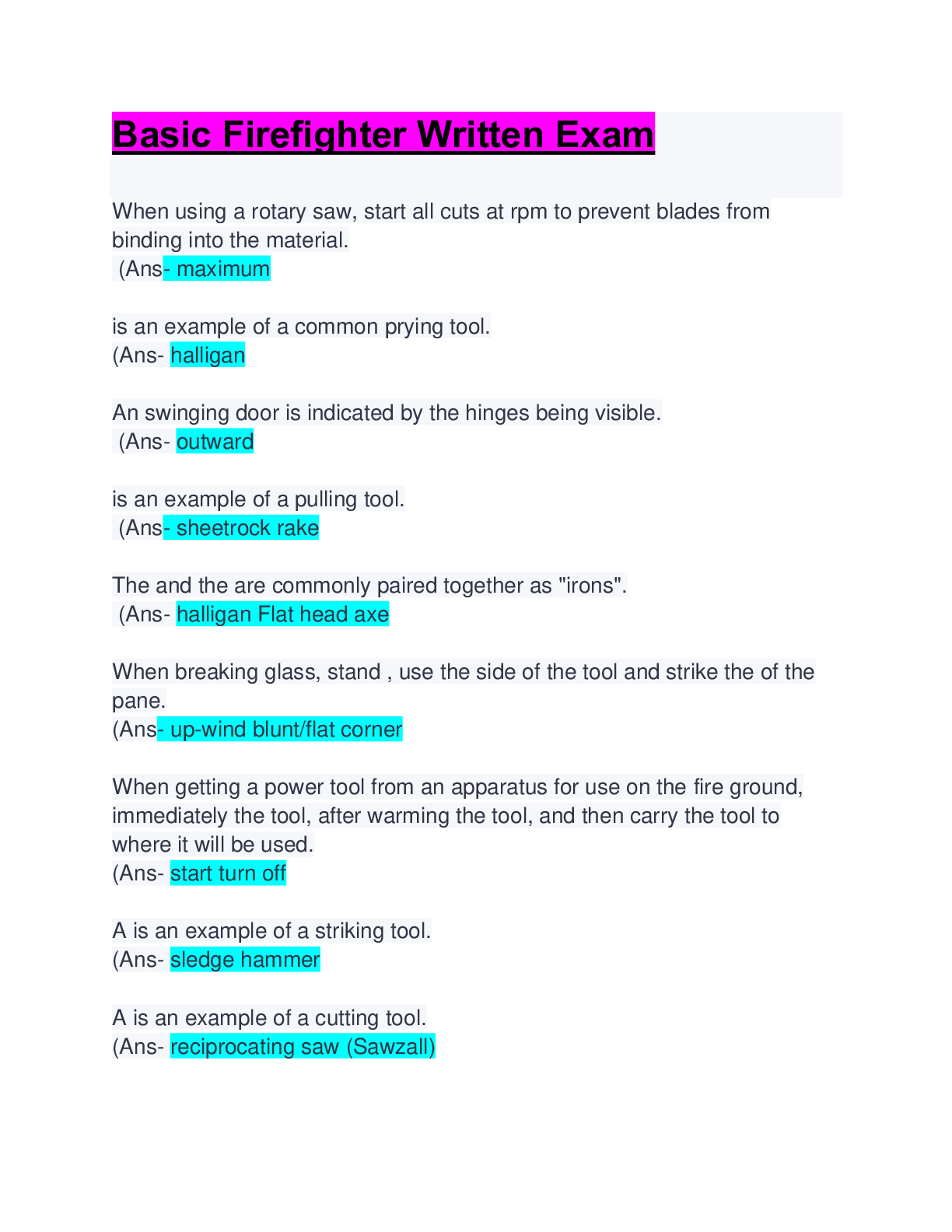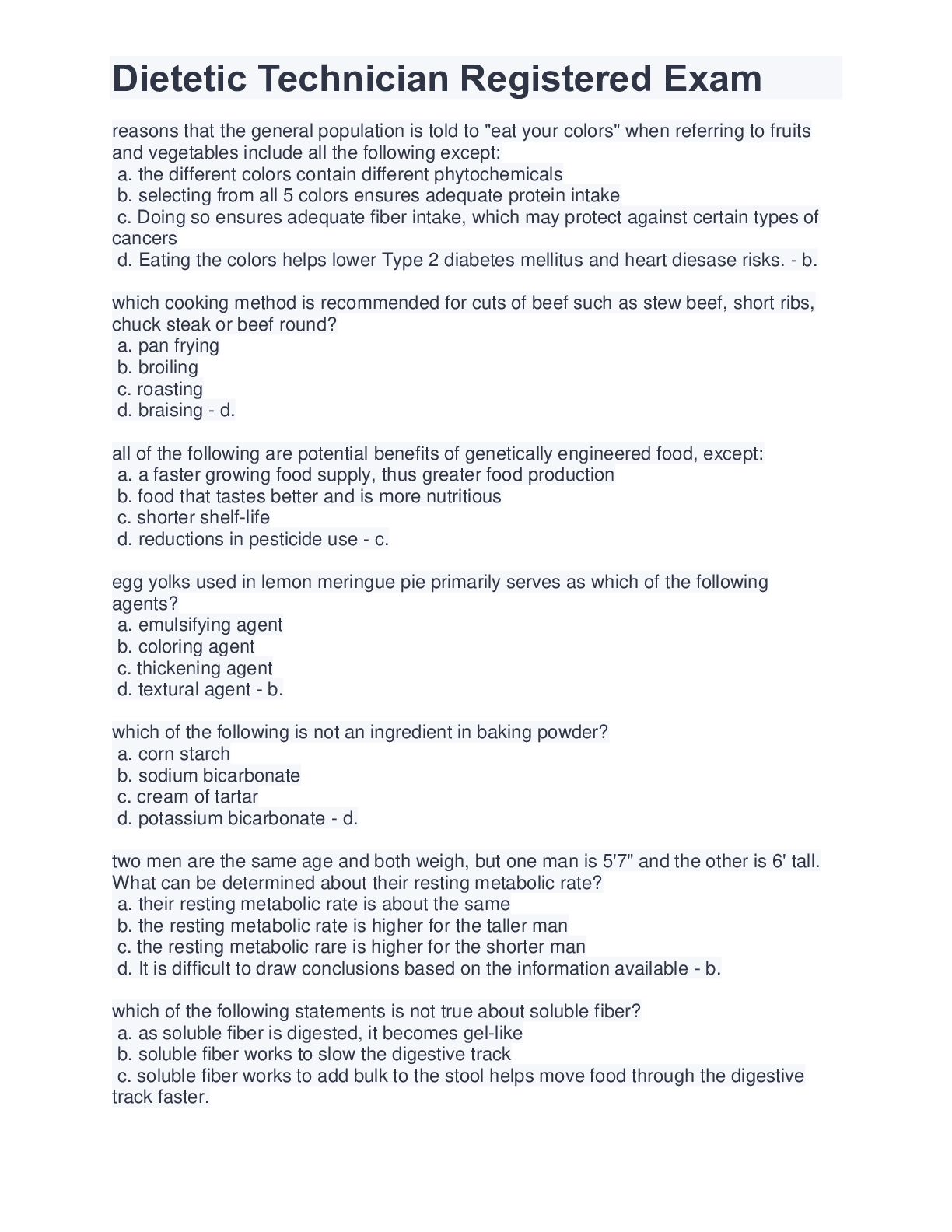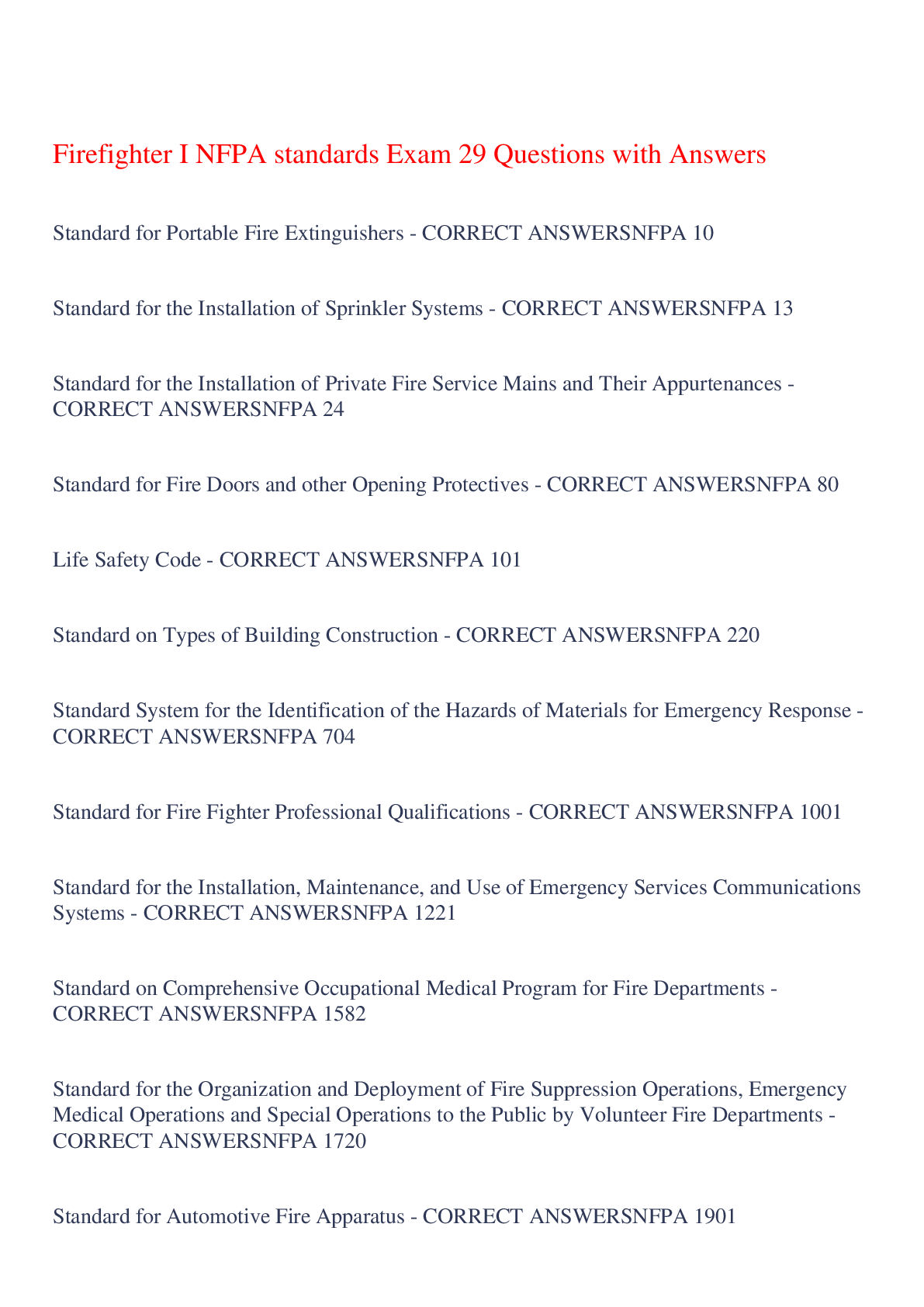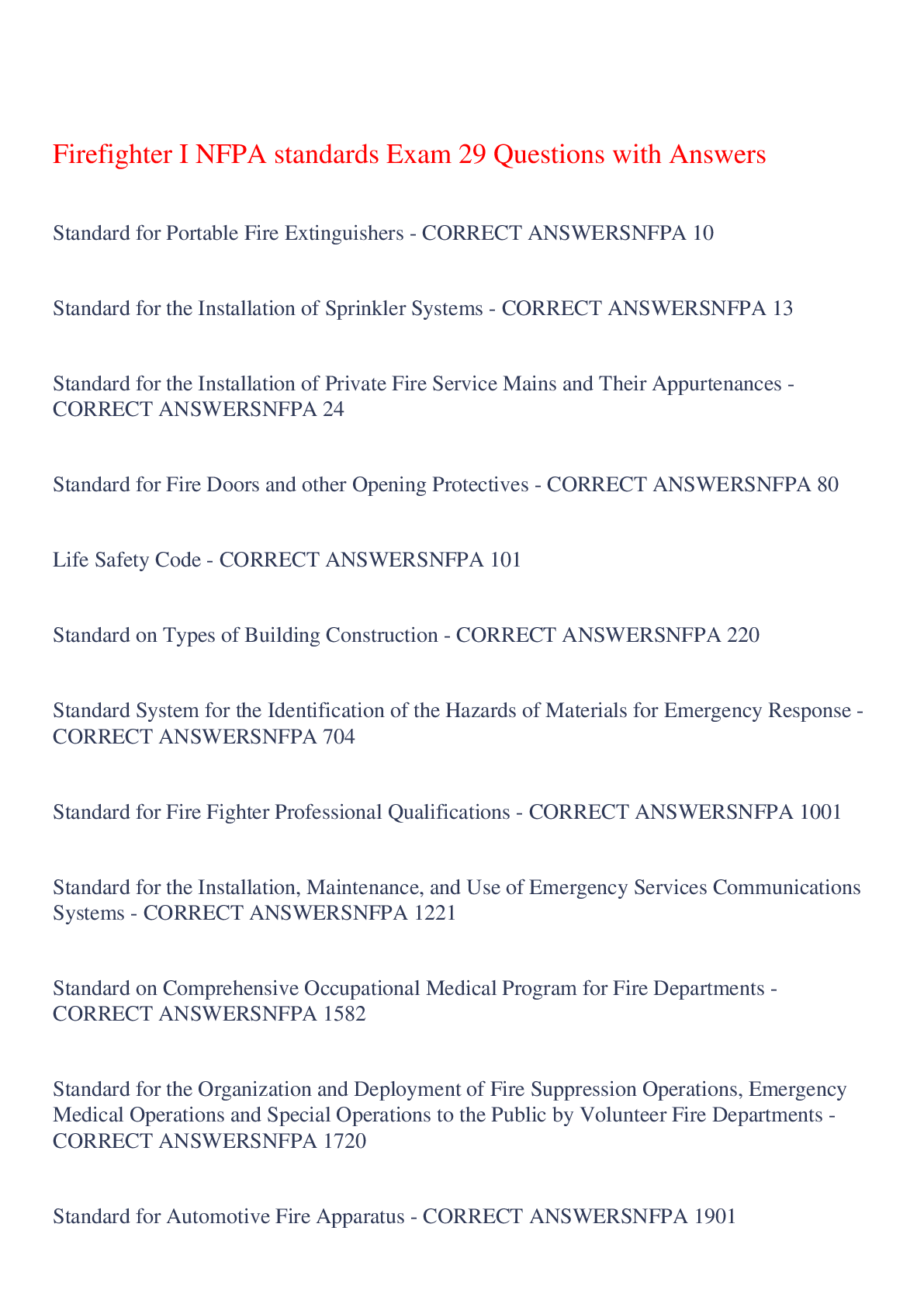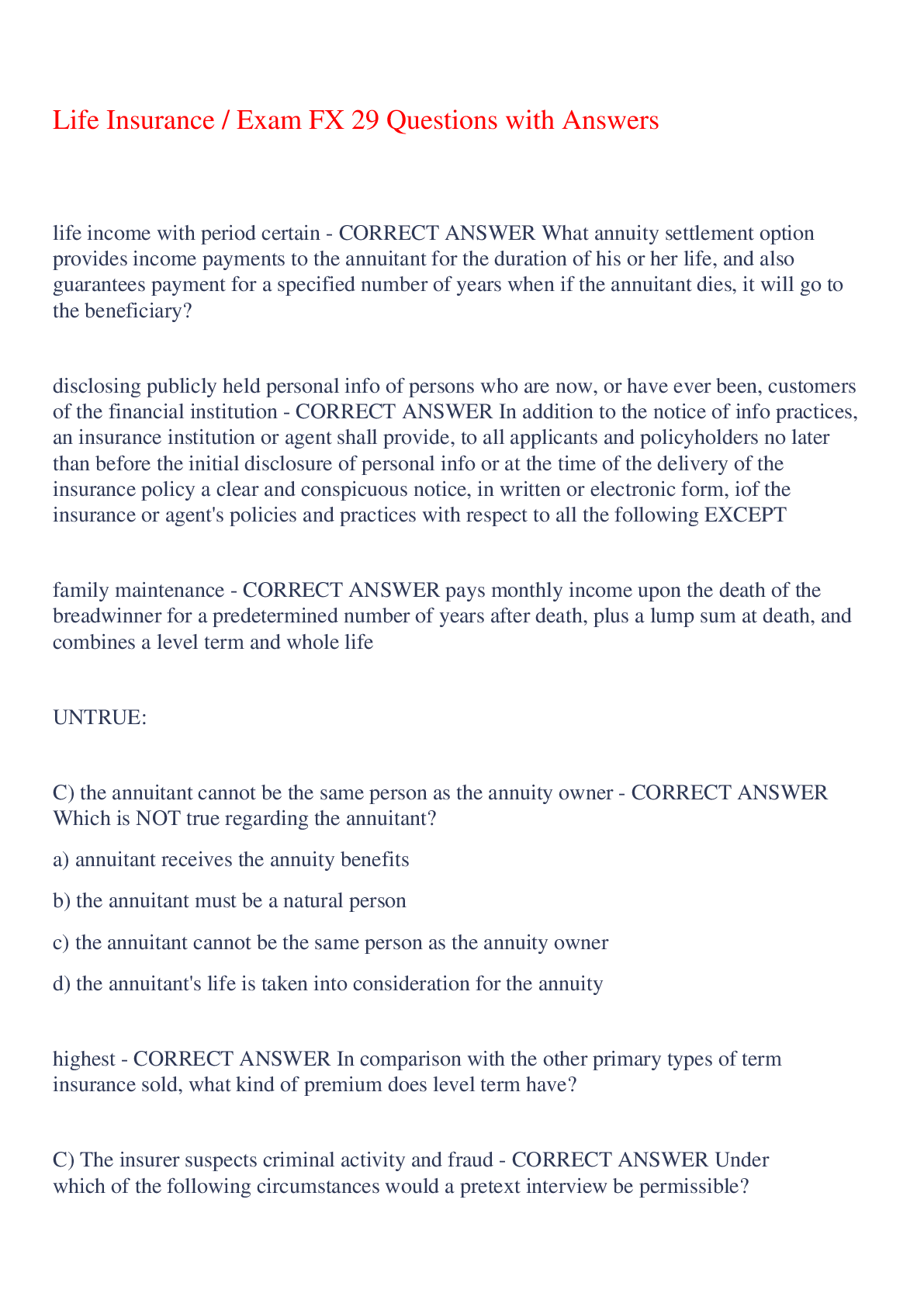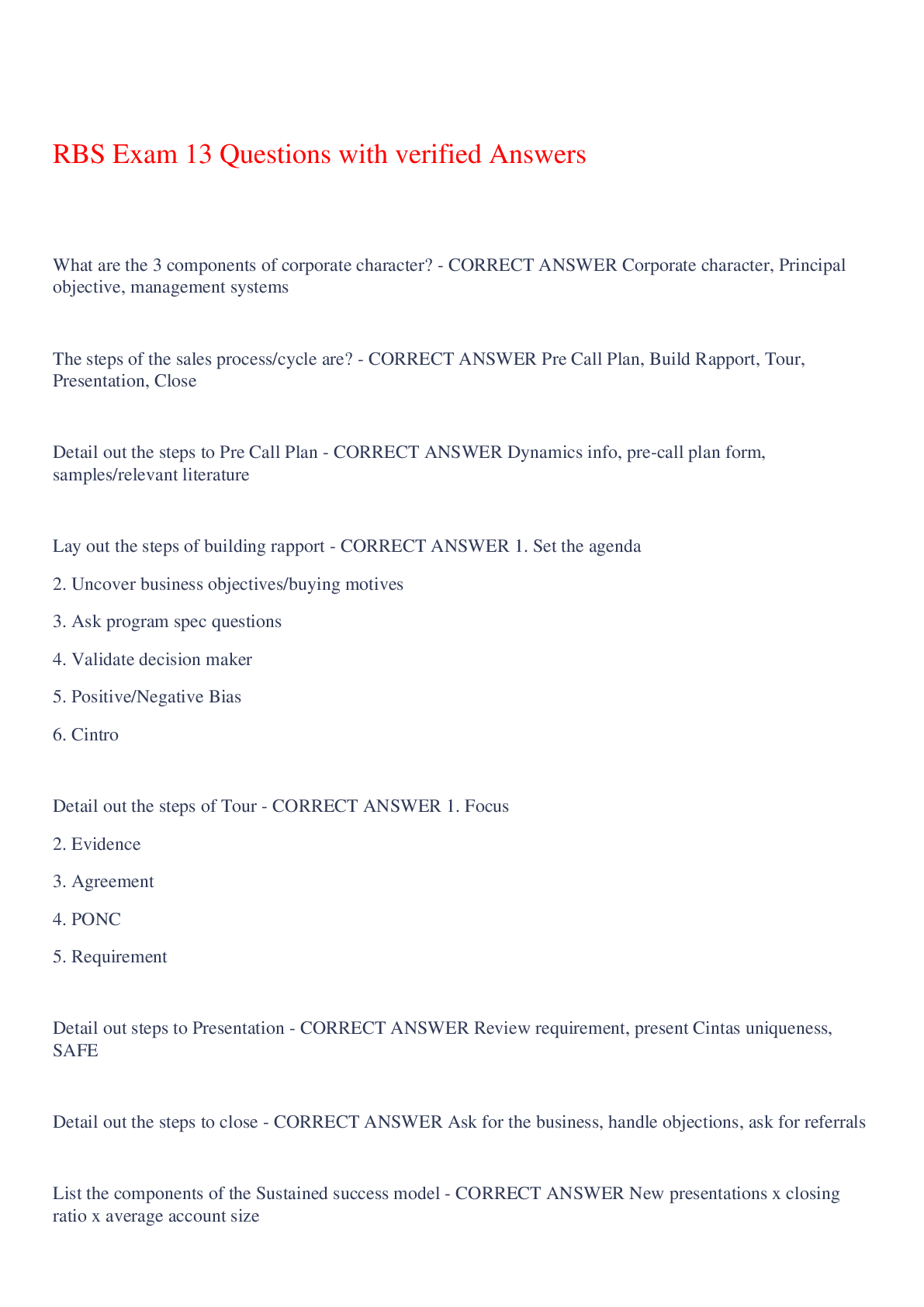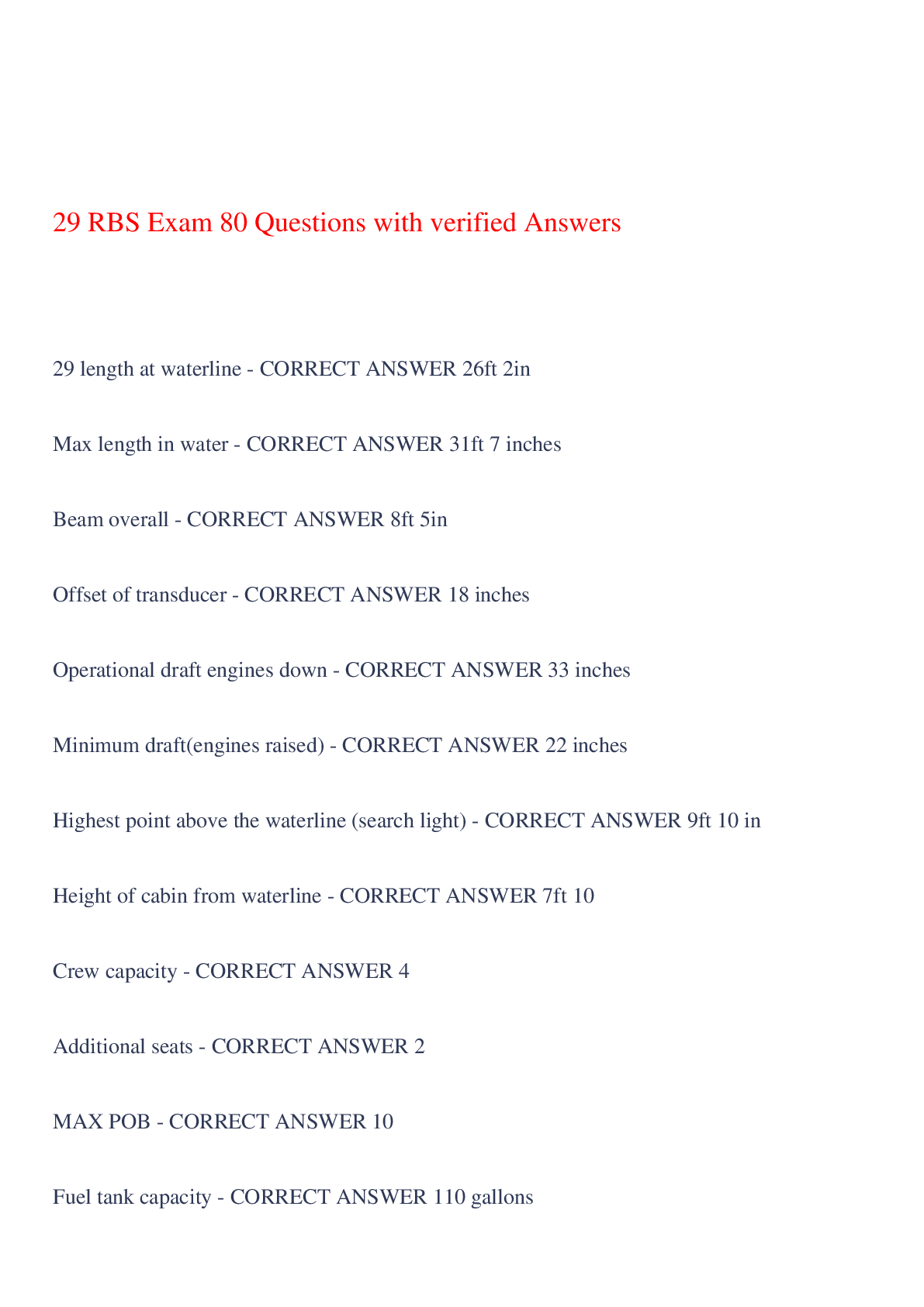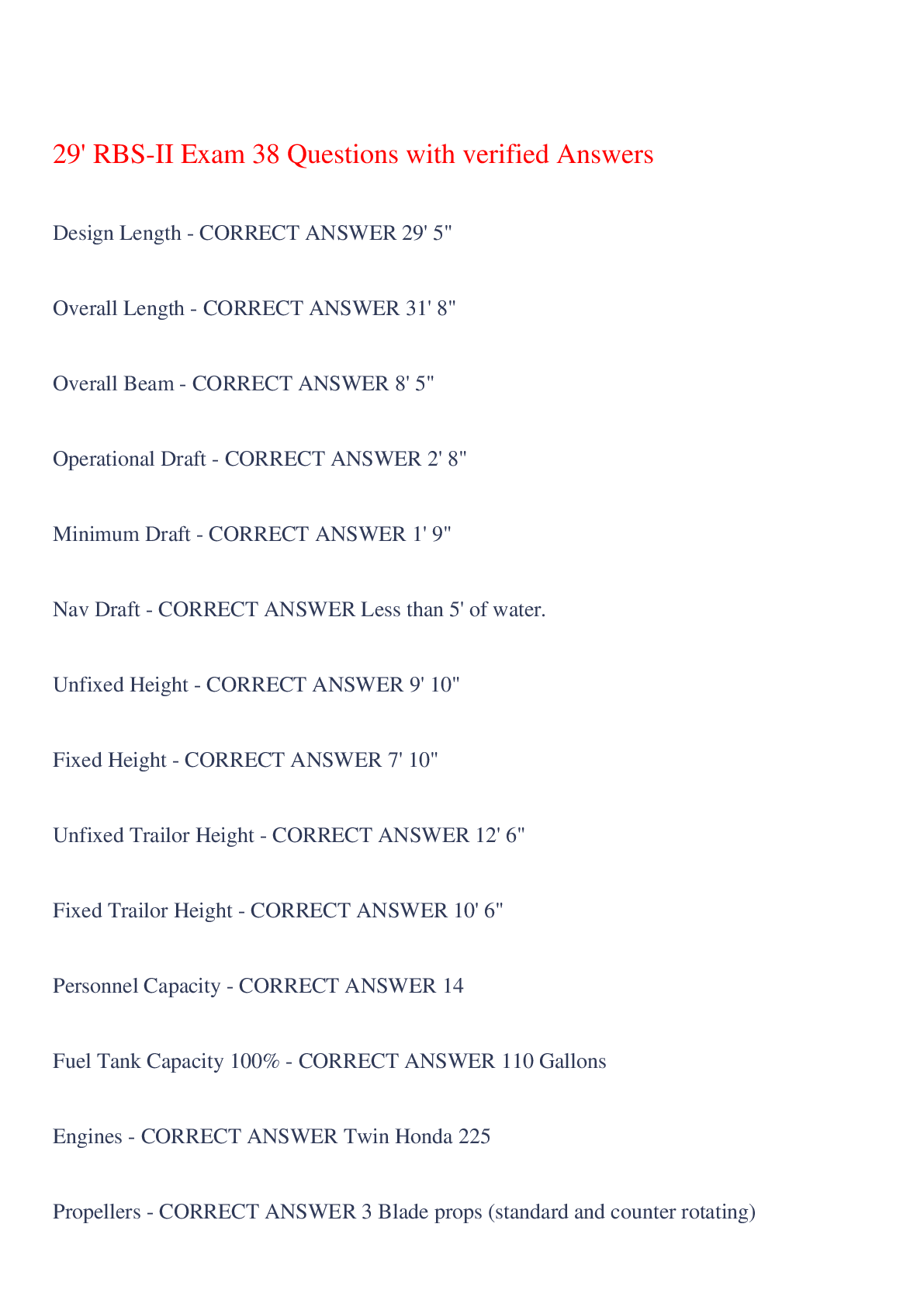Professionalism Exam 29 Questions with Verified Answers,100% CORRECT
Document Content and Description Below
Professionalism Exam 29 Questions with Verified Answers Discuss the role of the APRN and PA. - CORRECT ANSWER In addition to the role of the RN, the APRN is able to assess patients as well as initi... ate diagnostic tests and procedures to improve patient outcomes. APRN's are also able to make diagnoses and provide patients with therapeutic interventions (they have prescribing capabilities) through evidence-based practices and knowledge (American Nurses Association, 2015). Health promotion, education and research are in the scope of practice of both APRNs and PAs. PAs are able to conduct physical exams, diagnose and treat illnesses, order and interpret tests, develop specific treatment plans, prescribe medication, perform procedures and assist in surgeries What are the differences (APRN vs PA)? - CORRECT ANSWER One benefit of being a nurse practitioner is the autonomy that the profession allows. Nurse practitioners have full practice in some states, and full prescription privileges in all 50 states. In non-full practice states, APRNs must have a collaborative agreement with a physician (McCleery, 2014). Unfortunately, PAs must work under the license and agreement of a physician. APRNs follow the nursing model which is focused on holistic and population based patient care and PAs follow the medical model (American Academy of PAs, 2021). Nurse practitioners can practice in primary care settings, pediatrics, gerontology, mental health and women's health facilities (American Nurses Association, 2015). PAs concentrate in a specific area such as the ER, surgery, women's health and internal medicine Examine the education requirements for each. - CORRECT ANSWER PAs are required to obtain a bachelor's degree in any health related field (with the required program prerequisites) and APRNs are required to have completed a BSN RN degree. Both then require the completion of a masters program and sometimes a doctorate degree (Florida Board of Nursing, 2021). PAs complete 1000 group didactic hours and 2000 clinical hours and sit for the PANCE board exam (American Academy of PAs, 2021). Nurse practitioners are required to have undergone 500 didactic hours and 500 clinical hours to sit for the board exam (Florida Board of Nursing, 2021). The board exam for APRNs is the AANP or ANCCE Explore the current evidence regarding how the APRNs contribute to healthcare. - CORRECT ANSWER According to AANP, 75% of APRN practice in primary care. They are a vital part of the primary care workforce in the United States(AANP,2018). Research shows that Nurse practitioners are able to provide high quality care while being cost effective. Nurse Practitioners are able to provide care of equal or sometimes better quality care at a lower cost compared to other providers. One Study even showed that APRN services in emergency room settings showed reduced waiting time as well as provide care that can be compared to a midgrade physician (Woo, 2017). When there are APRNs in healthcare this can lead to the population to have greater access to emergency, critical care as well as primary care which can strengthen the healthcare team in order to meet the increased demands of healthcare. The value of the APRN is seen because they are helping with patient care across the board when it comes to communication, discharge planning, follow-up care as well as administrative work(Woo, 2017). While patients see NP it shows decrease patient's length of stay was shortened. In conclusion, APRN shows that they reduce cost of care, nursing management shows that they deliver 23% below average cost. They save money for patients, tax payers and it helps patients prevent loss of time and income from work. Research shows that their outcome of care is similar if not the same as doctors and are seen more in underserved rural areas. Describe any barriers that APRNs may encounter working as an APRN - CORRECT ANSWER Working as an APRN could come with several barriers when it comes to the workplace environment. The first barrier can be the regulations that the state enforces. Even though there is evidence showing data and evidence in support of full practice authority many states continue to deny APRN the right to practice to the full extent of the license they carry(Kleinpell, et al.., 2014). Some of the barriers include poor role clarification, proliferation of APRN titles, differing educational requirements and degrees, scope of practice issues, and fragmentation/ variability in standards and quality of educational programs (Kleinpell, et al.., 2014). Some of the other barriers are lack of public awareness on APRN roles meaning that many patients do not know what APRN do. Another issue is that Physicians themselves are not completely aware of what an APRN can do during a clinic. Also, the physicians think they are more valuable when compared to APRN because they consider themselves to have more education compared to APRN. Another issue is the reimbursement issue they are facing. In conclusion, there is a federal, state as well as institutional limit to APRN practice and in turn creates delays when it comes to care, raises the cost of care and can make it harder for patients to get services such as primary care etc. What is the consensus model - CORRECT ANSWER The consensus model provides guidance for states to adopt uniformity in the regulation of APRN roles. This includes licensure, accreditation, certification and education (LACE). The model allows for the facilitation & regulation of safe and competent advanced practice registered nurses (APRNs) in every state. Unfortunately, this model is not binding to the 50 states. It is just a guideline for states to follow (American Nurses Association, 2015). This model could apply/be beneficial to APRNs who are traveling across state lines to provide care in emergency situations. For example, to provide care to covid patients in other states, in which the nurse is not licensed. What can or can't I do in practice? For example, can I perform I&D's - CORRECT ANSWER An APRN in practice can do the following but are not limited to: ordering, conducting and interpreting diagnostic and laboratory tests; prescribing pharmacologic agents and non-pharmacologic therapies; and teaching and counseling (ANA,2015). APRN usually do not perform complex surgical procedures, they can perform some invasive treatment procedures. Performing or ordering preventative and diagnostic procedures based on the patient's age and history ARNP can perform I&D, respiratory procedure, microscopy, as well as do feral monitoring. Always take into consideration that the APRN scope of practice is dependent on age of foci. Depending on where the APRN works they can do intubations, pap smears, venous access placements. Suturing, prostate exams to name a few. In conclusion, what APRN can or cannot do is depending on the scope of practice dictated by the state. What do I need to obtain a license to practice in FL - CORRECT ANSWER For Licensure as an Advanced Practice Registered Nurse, the requirements are as follows and can be found in Section 464.012, F.S ( Florida Board of Nursing, 2021). Hold a valid Registered Nurse License from any US jurisdiction (at initial APRN licensure). Education Requirements: Applicants who graduated on or after October 1, 1998, must have completed requirements for a master's degree or post-master's degree certification. Certified Registered Nurse Anesthetist applicants who graduated on or after October 1, 2001, must have completed requirements for a master's degree program. Applicants who graduated prior to the applicable date are exempt from this requirement. Graduates from either a certificate or currently closed program should submit supporting documentation that demonstrates program compliance with Board guidelines. After July 1, 2006, applicants for licensure as an Advanced Practice Registered Nurse pursuant to section 464.012(1), F.S., shall submit proof of national advanced practice certification from an approved nursing specialty board. And, proof of malpractice insurance or exemption. What do I need to sit for national boards - CORRECT ANSWER According to the American Nurses Credentialing Center (ANCC), the requirements to sit for national boards are as follows. Hold a current, active RN license in a state or territory of the United States or hold the professional, legally recognized equivalent in another country. Hold a master's, post-graduate, or doctoral degree from a family nurse practitioner program accredited by the Commission on Collegiate Nursing Education (CCNE) or the Accreditation Commission for Education in Nursing (ACEN) (formerly NLNAC | National League for Nursing Accrediting Commission). A minimum of 500 faculty-supervised clinical hours must be included in your family nurse practitioner program. Three separate, comprehensive graduate-level courses in: advanced physiology/pathophysiology, including general principles that apply across the life span; advanced health assessment, which includes assessment of all human systems, advanced assessment techniques, concepts, and approaches; advanced pharmacology, which includes pharmacodynamics, pharmacokinetics, and pharmacotherapeutics of all broad categories of agents. What are the different boards? Which should I choose and why? - CORRECT ANSWER After completing graduate education, NPs are eligible to sit for national certification examinations (NCE) in their specialty areas. Certification examinations are offered by a variety of bodies: the American Nurses Credentialing Center (ANCC), the American Academy of Nurse Practitioners Certification Board (AANPCB), the Pediatric Nursing Certification Board (PNCB), the American Association of Critical Nurses Certification Corporation (AACNCC), and the National Certification Corporation (NCC) for the obstetric, gynecologic, and neonatal specialties (Blair, 2018). I would choose the ANCC because this certification aligns with the Consensus Model for APRN Regulation: Licensure, Accreditation, Certification and Education. Once you complete eligibility requirements to take the certification examination and successfully pass the exam, you are awarded the credential: Adult-Gerontology Primary Care Nurse Practitioner-Board Certified Nursing - CORRECT ANSWER •The importance of the word "nursing" in advanced practice registered nurse (APRN). •Advanced education enables APRNs to be differentiated from other educationally prepared nurses and other health care professionals. •Advanced practice nursing is moving towards the practice doctorate as entry into practice. Florence Nightingale - CORRECT ANSWER •To put the person in the BEST possible condition so nature can act on the person. Virginia Henderson - CORRECT ANSWER nurse collaborates with an individual to enhance the health status including health promotion and patient independence. Art & Science of Nursing - CORRECT ANSWER •The APRN supports and assists holistic patient care. •Presence, empowerment, reflection, listening, touch, empathy, humor, knowing the community, accessing care and directly providing care ensures patient satisfaction and quality evidence-based outcomes. Heuristic caring - technique- any approach to problem solve that employs a practical method that is sufficient for reaching a short term goal. Negotiable with the patient, problem solve & provide self discovery. Touch, listening, assessing and providing care, etc. •Patient care is the priority of the APRN: Direct Care - CORRECT ANSWER -Patient advocate -Educator to the patient and family -Case manager -Consultant -Collaborator Educator - CORRECT ANSWER •Most printed educational content should be constructed at a fifth- to eighth-grade reading level. ethics - CORRECT ANSWER •what one ought to do bioethics - CORRECT ANSWER •when the moral choice involves health care. ex. Abortion dilemma - CORRECT ANSWER •a situation where there are several unequally satisfying solutions, or when there is a conflict between one's values. Utilitarianism - CORRECT ANSWER •the right act is the one which produces the "most good for the greatest number". •Example: universal health insurance, where everyone has access, but perhaps the critically ill or those who require more resources do not get help because more resources could be given to more people who require less. Liver for patient: kid, athlete, or 90 yo •Offers an explanation of the consequences of action or inaction. Deontology - CORRECT ANSWER •Emphasizes duty, obligation, rule-based ethics. •Focus is on the rightness or wrongness of actions (under a series of rules) versus the consequences of those actions. •Obligation to act in a way that is prudent or right. •The means justify the ends. •Example: removing life support from someone who has little chance of recovery because this is what a reasonable person would want, yet there is no way of really knowing what the person actually desired. Ex. Patient stole shoes bcuz siblings cant go to school because they don't have shoes Teleology - CORRECT ANSWER •Virtue ethics (focus on person's moral character rather than rules). •The greatest amount of happiness and the least amount of harm. •The end justifies the means. •Examples: A nurse speaks to his/her director about someone engaging in illegal. behavior (stealing items) in the department or a person is unwilling to sacrifice their moral beliefs for personal advancement. •Autonomy - CORRECT ANSWER •Self-determination •Respect for all persons •Must respect an individual's thoughts and actions •Restricted by paternalism •Example: informed consent, respect for privacy, helping with decision making when asked. Nonmaleficence - CORRECT ANSWER •Duty not to cause harm. •This is the only principle NOT contained in the Belmont Report. •The foundation of health care. •Does not require taking positive action. •Example: coercing a patient to participate in unwanted chemotherapy or assisting someone in ending their life. Beneficence - CORRECT ANSWER Duty to prevent harm and promote good. Benefits should outweigh the risks when providing care. Actions should promote good. Uses the principle of proportionality. Example: performing CPR, keeping side rails up to prevent patient falls, administering pain medication in a timely manner when clinically indicated. Justice - CORRECT ANSWER •The duty to be fair & equitable. •Fairness, individual rights. •Complex and difficult to apply in health care. •Healthy People 2020: eliminate health disparities (vulnerable individuals). •Examples: Who should get the heart transplant? Who should get the remaining ventilator? Charlie Gard case. Veracity - CORRECT ANSWER •The duty to tell the truth •Truth-telling •Must use language that the patient understands (all patient education materials should be written at the 5th grade level). •Example: honestly explaining an advance directive. Confidentiality - CORRECT ANSWER •Respect for privileged information. •Crucial in the provider-patient relationship. •HIPAA •Breach of confidentiality can be a reason for disciplinary action or even termination (reviewing EHR of patient that you are not caring for). •Another example: not sharing patient's condition with visitors, family or friends. Fidelity - CORRECT ANSWER •Keep promises •Duty to be faithful •Avoid false expectations •Example: telling the patient you will request a consultation, and then following up on it [Show More]
Last updated: 7 months ago
Preview 1 out of 8 pages
Instant download
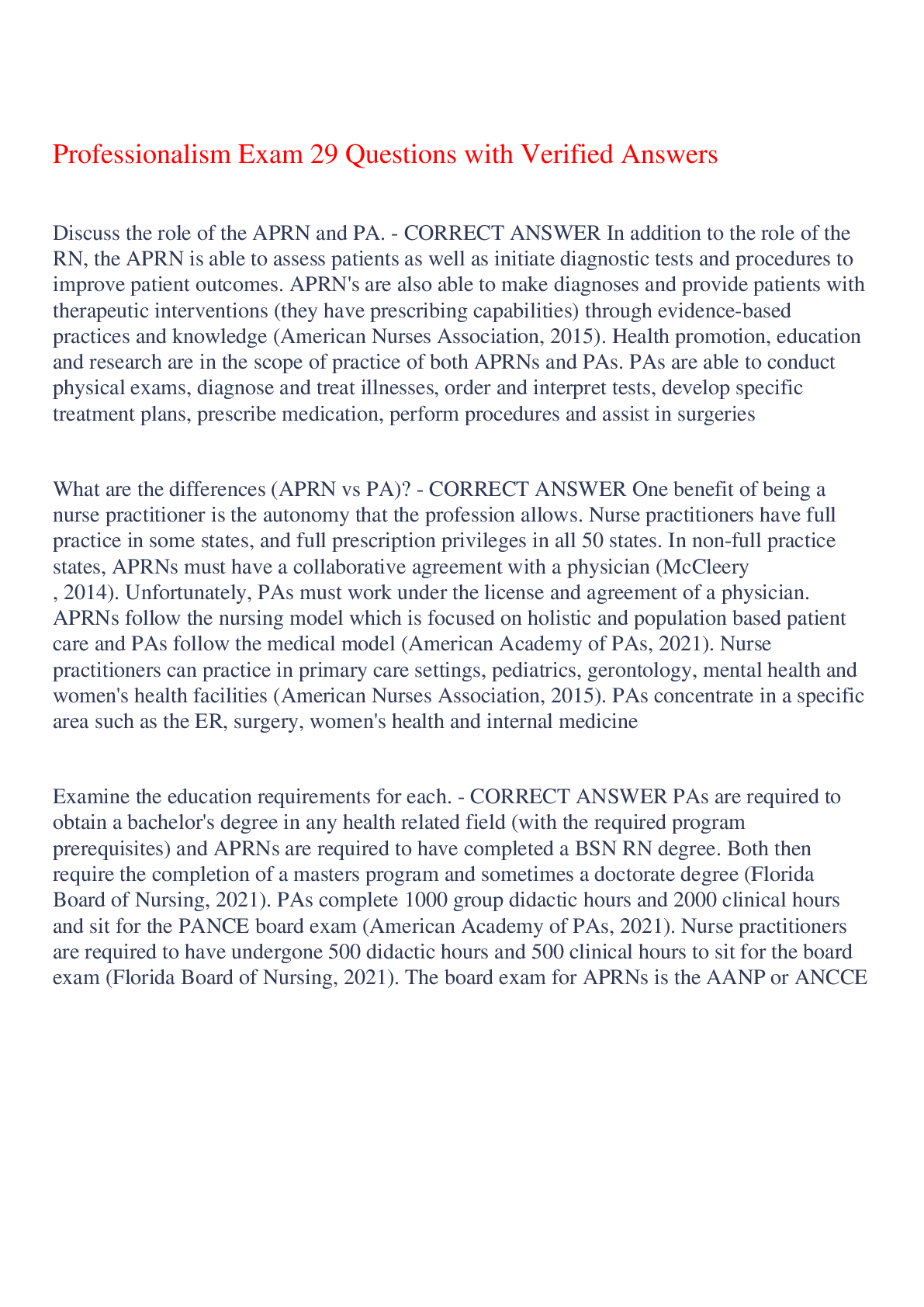
Buy this document to get the full access instantly
Instant Download Access after purchase
Add to cartInstant download
Reviews( 0 )
Document information
Connected school, study & course
About the document
Uploaded On
Oct 30, 2023
Number of pages
8
Written in
Additional information
This document has been written for:
Uploaded
Oct 30, 2023
Downloads
0
Views
53






